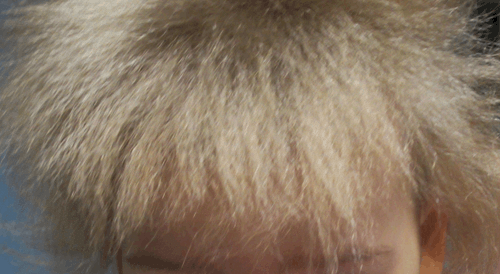By Amick Boone
(Editor’s note 8/21/202: This post has been slightly edited from when it first published in 2017.) Seven-year-old Shilah Yin likes being different. She even likes it when people describe her hair — a thick frizzy blond mane that juts out at all angles — as looking like the wacky time-traveling scientist Doc Brown’s from Back to the Future. Luckily it’s one of her favorite movies.

Source: Cobb HK, Tiu AY. “A case of uncombable hair syndrome and global developmental delays.” International Journal of Case Reports and Images 2017;8(2):108–111. doi:10.5348/ijcri-201718-CR-10757
Shilah has something called “uncombable hair syndrome.” It’s a real but rare genetic disorder affecting the hair shaft of the scalp characterized by silvery-blond or sometimes straw-colored hair that stands out from the scalp in a disorderly way and cannot be combed flat.
Stories published in Today and Daily Mail report that Shilah was born with brown hair, but a strawberry-blond fuzz began to appear when she was about three months old. From then on, it grew straight out from her scalp and became blonder.
Shilah says she’s special and unique, like a unicorn, and her family supports her positive attitude. They document her experience on Instagram to share how special Shilah is and to make others aware of the disorder.
A Rare Hair Disorder
Uncontrollable hair syndrome is specific to children, first appearing between three months and 12 years and usually improving or resolving by puberty.
The condition only affects a child’s scalp hair. While the amount of hair remains normal, it often grows slowly. Over time, the hair becomes progressively dry and turns silvery-blond or straw-colored, standing out and growing in different directions.
The first case of uncontrollable hair syndrome was reported in 1912, and in 1973, the syndrome was named “cheveux incoiffables” by doctors in France. In the 1980s, it also became known as “spun-glass hair.”
Does 23andMe Test for Uncombable Hair Syndrome?
23andMe doesn’t report on the genes that cause uncombable hair syndrome, but we do report on genes that influence other hair traits.
23andMe offers customers reports on hair curliness, hair color, newborn hair amount, unibrow, and widow’s peak. For men, we report on whether or not you’ve inherited genes that influence back hair, hair loss, or bald spots. Learn more.
How Genetics Contribute to Uncombable Hair Syndrome
According to the National Institutes of Health, the syndrome is caused by variants in the genes PADI3, TGM3, and TCHH. These three genes code for proteins involved in hair shaft formation. The syndrome appears to be inherited in an autosomal recessive fashion, which means that if both parents are carriers, there is a 25 percent chance of their child inheriting both abnormal variants and, consequently, developing the syndrome. There is a 50 percent chance of a child inheriting only one abnormal gene and being a carrier. There is also a 25 percent chance of the child inheriting both normal variants.
These are the variants that researchers know about. Scientists also suspect that some cases of uncombable hair syndrome are caused by other genes that have not yet been identified. These could be inherited, by contrast, in an autosomal dominant manner, meaning that having a variant in only one copy of the responsible gene in each cell is enough to cause the condition. When a person with a variant that causes an autosomal dominant condition has children, each child has a 50 percent (1 in 2) chance of inheriting the variant.
Many of these autosomal dominant cases may occur with “reduced penetrance,” which means that not all people with a variant in the responsible gene will have uncombable hair syndrome. With reduced penetrance, a condition may appear to “skip a generation” or may appear to occur for the first time, or only once, in a family.
Diagnosing Uncombable Hair Syndrome
People with uncombable hair syndrome often report that no one in their family has had it, and that may well be the case, from what they can see. However, hair shaft abnormalities associated with the syndrome have shown up in unaffected family members when they looked at their hair under a specific type of microscope.
The individual hair strands are either triangular or kidney-shaped in cross-section. The hair strands have a groove along one or two faces. To diagnose uncombable hair syndrome, doctors observe symptoms. They also look under a microscope for these characteristic hair strand qualities.
Is there Treatment for Uncombable Hair Syndrome?
Unfortunately, there is no proven treatment for the syndrome. However, the condition usually improves or resolves on its own with the onset of puberty. Gentle hair care is recommended using conditioners and soft brushes. It’s also recommended to avoid harsh hair treatments, excessive brushing, and blow-drying. Some published studies suggest that biotin supplements may improve the condition.
Shilah, for her part, loves her unruly hair. She especially likes it when her dad combs and dries. Together, they want to fluff it up as big as it can get.
Learn more about how genetics influences your hair color, curl, thickness, and texture here.
Amick Boone is a freelance writer who has written about health and life sciences for over a decade. When she’s not at her computer, she’s usually in motion – doing yoga, riding her bike or traveling.




